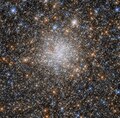File:NGC1898 - HST - Potw1840a.tiff
外觀

此 TIF 檔案的 JPG 預覽的大小:610 × 600 像素。 其他解析度:244 × 240 像素 | 488 × 480 像素 | 781 × 768 像素 | 1,041 × 1,024 像素 | 2,082 × 2,048 像素 | 2,913 × 2,865 像素。
原始檔案 (2,913 × 2,865 像素,檔案大小:21.67 MB,MIME 類型:image/tiff)
檔案歷史
點選日期/時間以檢視該時間的檔案版本。
| 日期/時間 | 縮圖 | 尺寸 | 使用者 | 備註 | |
|---|---|---|---|---|---|
| 目前 | 2018年10月1日 (一) 05:31 |  | 2,913 × 2,865(21.67 MB) | Fabian RRRR | == {{int:filedesc}} == {{Information |description={{en|1='''Celestial fairy lights Celestial fairy lights This glittering ball of stars is the globular cluster NGC 1898, which lies towards the centre of the Large Magellanic Cloud — one of our closest cosmic neighbours. The Large Magellanic Cloud is a dwarf galaxy that hosts an extremely rich population of star clusters, making it an ideal laboratory for investigating star formation. Discovered in November 1834 by British astronomer John Her... |
檔案用途
下列頁面有用到此檔案:
全域檔案使用狀況
以下其他 wiki 使用了這個檔案:
- ar.wikipedia.org 的使用狀況
- az.wikipedia.org 的使用狀況
- be.wikipedia.org 的使用狀況
- bs.wikipedia.org 的使用狀況
- ce.wikipedia.org 的使用狀況
- de.wikipedia.org 的使用狀況
- diq.wikipedia.org 的使用狀況
- el.wikipedia.org 的使用狀況
- en.wikipedia.org 的使用狀況
- eo.wikipedia.org 的使用狀況
- eu.wikipedia.org 的使用狀況
- fr.wikipedia.org 的使用狀況
- hr.wikipedia.org 的使用狀況
- kk.wikipedia.org 的使用狀況
- mk.wikipedia.org 的使用狀況
- nl.wikipedia.org 的使用狀況
- pl.wikipedia.org 的使用狀況
- pt.wikipedia.org 的使用狀況
- ru.wikipedia.org 的使用狀況
- sh.wikipedia.org 的使用狀況
- sk.wikipedia.org 的使用狀況
- sr.wikipedia.org 的使用狀況
- tr.wikipedia.org 的使用狀況
- tt.wikipedia.org 的使用狀況
- uk.wikipedia.org 的使用狀況
- uz.wikipedia.org 的使用狀況
- www.wikidata.org 的使用狀況



